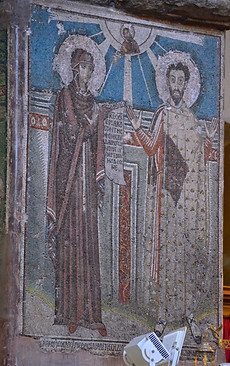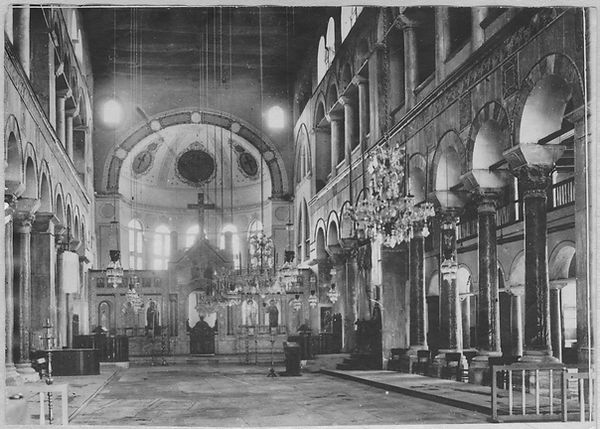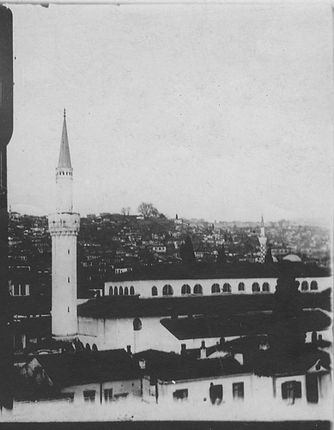Church of St. Demetrios (Thessaloniki)
On the north side of the Agora, the Church of Hagios Demetrios stands an area where there was a large public baths complex in Roman times. It is one of the 15 Paleochristian and Byzantine Monuments of Thessaloniki that were included in the UNESCO World Heritage List in 1988.
According to tradition, it was in these baths that the Christian Demetrios, a Roman officer who had been arrested in the Chalkeutiki stoa in the Agora, was imprisoned during the persecution under Diocletian, on the orders of Galerius. Demetrios was martyred here too, by being speared to death, and his corpse was buried secretly by his fellow Christians. After the Edict of Milan had proclaimed religious tolerance in 313, a small oecius of worship was created in part of the baths, on the site where the saint was martyred, which was also believed to be the site of his tomb.
In the 5th century, Leontios, eparch of the Illyrikon theme, in gratitude for being cured of illness by the miraculous grace of the martyr, built a large basilica on the same site, and transferred to it the tomb of the saint, which was placed in a ciborium in the central aisle. The original, silver ciborium was later replaced by a marble one, containing the coffer, probably a cenotaph, and the saint's icon. The base of the hexagonal ciborium is preserved on the floor in the left part of the central aisle. (The ciborium now to be found in the north aisle is a modern one.)
The 5th century basilica was burnt after the earthquake of 620 and was renewed at this date, under the care of the Bishop of Thessaloniki and Leo, the Eparch, as we are informed by the mosaic founder's inscription now in the crypt of the nave. The 7th century basilica seems to have retained the form of the 5th century church, large parts of which were incorporated into it.
Throughout the Byzantine period, the worship of Saint Demetrios and the Christian belief in his miraculous grace spread far beyond the bounds not only of the city which he protected against barbarian raids, but also the boundaries of the Byzantine empire itself. The Demetria, the festival held every October by the city in honor of its patron saint, attracted pilgrims from many countries in Europe and Asia who, when they returned home, took with them as amulets small bottles containing myrrh front his tomb. In 1493 the Turks converted the church into a mosque (Kasımiye Camii), leaving to the Christians part of the Roman baths to the north-west of the church in which to worship the saint. The saint's cenotaph from the ciborium was transferred here. The church of Hagios Demetrios was restored to Christian worship after the liberation of Thessaloniki from the Turks in 1912. The great fire that destroyed the centre of the city in 1917 burnt down the bigger part of the church for the second time. The restoration of the church, which preserved and incorporated those parts that had escaped the fire, was brought to completion in 1949.
The basilica of Hagios Demetrios is a five-aisled church with a three-aisled transept at the east. From the long, rectangular narthex, we proceed to the central aisle through the luxurious tribelon, while two arched openings at the ends of the narthex lead to the side aisles. Part of the Roman baths, converted into a chapel containing the saint's cenotaph, is incorporated into the north-west end of the north aisles. The nave is divided into five aisles by means of four long colonnades. Two pairs of large piers are interposed amongst the columns of the central aisle. The five aisles terminate at the east end of the church in a transept that projects from the width of the church and forms the symbolic shape of a Latin cross. The central part of the transept corresponds to the sanctuary, which is separated from raised side ‘wings’ by large, transverse arches. Each wing of the transept is divided by a Π-shaped colonnade into three parts. To the east side of the south wing of the transept was attached the Impel of Saint Euthymios, while the trance to the underground crypt of die church is on the west face of the south wing. In the sanctuary, beneath the altar, is an enkainion in which was mind a marble ossuary containing a small bottle of the martyr's blood.
One of the features of the basilica that give it its special character is its sculptural decoration. In the tribelon, the long colonnades of the nave and the transept, the windows, and the galleries, are to be found column capitals in a wide variety of forms and styles; these come either from earlier Roman or Christian buildings, or from the 5th century basilica, and were reused in the 7th century 'renewal' of the church. The Early Christian column capitals, in particular, cover the development of sculpture in the 5th and 6th century, with a variety of two-zone Theodosian capitals with doves, rams and eagles at the corner of the abacus, capitals with waving leaves, and fold capitals. The picture of Early Christian sculpture is completed by the cornices and the impost blocks of the pilasters. A contribution to the luxurious decoration of the church is also made by the marble facing on the intrados of the tribelon and the wings, the original marble revetment, and the panels of opus sectile, of which a few examples are still preserved on the walls above the colonnades of the central aisle. In addition to the sculptural decoration, the first intercolumniation from the west in the colonnade on the north side of the central aisle has a marble funerary monument of great artistic value, representing as it does the Renaissance art of Venice. This is the tomb of Loukas Spandounis, a wealthy merchant and notable of Thessaloniki, who was interred in the church of the patron saint of the city just after 1481. The monument incorporates a large verse inscription.
Another special feature of the decoration of Hagios Demetrios are the dedicatory mosaic panels, offered by ordinary citizens and officials of the city. Only nine of these mosaics, on the two large piers at the east of the sanctuary and the west wall of the nave, escaped the great fire of 1917. These mosaics, which cover the period from the 5th to the 9th century, are as follows:
1) On the east face of the west wall of the north aisle, above the entrance to the narthex, is a frontal depiction of Saint Demetrios wearing consular uniform. To his right, amongst colored clouds, is an angel playing a trumpet. Two figures in a naturalistic landscape, with other-worldly, introspective gazes, lend a distinctly transcendental atmosphere.
2) In the corresponding position in the south aisle, above the arched entrance from the narthex, is a mosaic depicting children making offerings to the saint, who is depicted frontally in the centre, in a typical, transcendental attitude of supplication, with his gold palms upraised; the figure of the saint is possibly modeled on a portable, cult icon. All around him, in a landscape full of strong color and light, unfolds a scene of children being vowed to the saint.
3) On the west wall of the central aisle, next to the tomb of Loukas Spandounis, another mosaic depicts Saint Demetrios amongst four priests, on the battlements of the city walls. The conventional, linear treatment recalls the style of the 7th-8th century.
4) On the north face of the south pier of the sanctuary, the founder's inscription in the mosaic scene informs us that it depicts Saint Demetrios with the Bishop of Thessaloniki and the Eparch Leo, who renewed the basilica in the 7th century, rendered conventionally in front of the battlements of the city wall. The realistic portraits of the two figures, and the rich drapery of their garments contrast with the transcendental treatment of the face and chlamys of the saint.
5) On the east face of the same pier is another figure of the martyr, with his arm around the shoulders of a deacon. The latter has pronounced facial features, and is probably to be identified with the deacon who helped in the reconstruction of the church after it was destroyed in 620, an event recorded in the Book of Miracles of Saint Demetrios. The participation of the citizens, and also of foreigners, in this rebuilding of the church is probably the reason why the saint is asked to protect them in the inscription associated with the mosaic.
6) On the west face of this same pier Saint Sergios is depicted in an attitude of supplication, wearing a purple chiton with military insignia at his neck.
7) On the west side of the pier on the north of the sanctuary, is a scene of Saint Demetrios with two children, a boy and a girl, who are shown by their dress to be of an aristocratic family. The saint is raising the right hand in a gesture of supplication, while his left rests on the girl's shoulders.
8) On the east side of the same pier is another scene of Saint Demetrios in an attitude of supplication, dating from the 7th-8th century, which is a copy of the cult icon of the saint, with the gold palms, in the nave.
9) On the south face of the north pier, a dedicatory mosaic Deesis, dating from the 9th century, depicts the Virgin and a military saint, probably Saint Theodore, in an attitude of supplication, while Christ can be seen blessing in a semicircle in the heavens.
Fragments of two more mosaics survived the fire of 1917 and, having been mended and conserved, are now on display in the Exhibition in the White Tower. One comes from the small colonnade on the north side of the church, where we know that there were dedicatory mosaics, dating from the 5th to the 7th century, on the wall above the arcade. The surviving mosaic depicts Saint Demetrios, in an attitude or supplication before a niche, and the figure of the person making the dedication, who is shown next to the saint, on a smaller scale. The second mosaic comes from the intrados of an arch in the west gallery and has a peacock in front of a large vase containing water. Very few wall-paintings survived the great fire of 1917. The painting on the south wall of the church is very important from a historical point of view: it depicts a mounted emperor entering the city with his military retinue, and a church put to the torch. There are grave difficulties of interpretation involved here. According to one view, the emperor is to be identified with Justinian II (685-695 and 705-711), portrayed here in connection with a victorious campaign against the Slavs. Another theory identifies him with Basil II and connects the wall-painting with his recapture of Sirmium (1019).
The second pier in the colonnade at the south of the central aisle has a representation of Hosios Loukas of Styris wearing monk's garb, which is dated to the late 11th century. Hosios Loukas carried out his askesis at the beginning of the 10th century in Phokis, where the monastery dedicated to him was erected. On the first pier in the colonnade to the south of the central aisle is a depiction of Saint Ioasaph with a church father on a smaller scale next to him. The scene has been interpreted as depicting the emperor John VI Kantakouzinos, who became a monk towards the end of his life, with the name loasaph, and Gregory Palamas, Archbishop of Thessaloniki who is censing the saint, thereby also honoring the emperor. The scene is probably to be associated with Hesychasm and the theological controversies of the 14th century in Thessaloniki, in which case it will be a work of the period 1360-1380.
The Chapel of Hagios Euthymios is attached to the east side of the south wing of the transept. It is in the form of a small three-aisled basilica, and is decorated with an interesting ensemble of wall-paintings. According to an inscription on the north wall, the cost for the decoration was defrayed in 1302-1303 by the protostrator Michael Doukas Glavas Tarchaneiotis, who was the founder of the Pammakaristos Monastery in Constantinople, and his wife Maria Palaiologina. The wall-paintings of the chapel are representative examples of Palaiologan art of the early 14th century in Thessaloniki, and follow the iconographic program typical of the period, with scenes from the Dodekaorton, the Miracles and Teaching of Christ, and from the Synaxarion of Saint Euthymios. The scenes are unfolded as a narrative, one next to the other, and are not divided into separate panels.
The Crypt beneath the Church of Hagios Demetrios is the east section of the Roman bath in which, according to tradition, the saint was imprisoned and martyred by the spear. Throughout the Early Christian and Byzantine periods the Crypt, with the ciborium, was the main place of worship of the martyr, and was related in particular to the belief that myrrh issued from his wounds.
In the Roman period, the Crypt stood at ground-floor level. Today, entrance to it is from the south transept in the church. Descending the staircase, we encounter a small, aisleless church on the left, with a pierced window in the sanctuary apse. This small church is thought to have been the oecus built by the Christians on the site of the martyr's grave. The small pierced window recalls the fanestrella found in tombs of martyrs.
The Crypt consists of a small, semi-circular room formed by four pillars arranged in a semicircle, with colonnades enclosing it. The semicircle is Placed before a willl with live niches and a Roman limn lain that was converted into a shrine when the basilica was erected. During the Middle Byzantine period, when the worship of the saint as myrovlitis became established, the fountain was equipped with a triple reservoir with closure slabs; in the center was a semicircular ciborium with seven columns, and in front of that a built, circular basin, from which the faithful drew the myrrh. The pilgrims carried off the miraculous myrrh to their homelands in small lead bottles, called koutrouvia, in amulets and in small precious boxes.
The Crypt was filled with earth deposits when the church was converted into a mosque, during the period of Ottoman rule. It was rediscovered after the fire of 1917. When the church was restored it was made into a small exhibition area.
Page under construction
René Prouho (1916)
René Prouho (1916)
Alméry Lobel-Riche (1916)
1917 Photo
Paul Fils (1917)
Albert Gabriel (1908-1934)
Albert Gabriel (1908-1934)
Aristotle University of Thessaloniki
Aristotle University of Thessaloniki
Aristotle University of Thessaloniki
After the destructive fire of 1917
Byzantine and Christian Museum
Aristotle University of Thessaloniki
Aristotle University of Thessaloniki
Aristotle University of Thessaloniki
American School of Classical Studies at Athens
Homer A. Thompson Collection
Aristotle University of Thessaloniki

Plan from G. Soutiriou and M. Soutiriou
Sources
Byzantine Architecture by Cyril Mango
Architecture in the Balkans from Diocletian to Süleyman the Magnificent by Slobodan Ćurčić
Early Christian and Byzantine Architecture by Richard Krautheimer
Wandering in Byzantine Thessaloniki by Tourta and Kourkoutidou-Nikolaidou
Oxford Dictionary of Byzantium edited by Alexander Kazhdan
Resources
St. Demetrios Thessaloniki Album (Byzantine Legacy Flickr)
Museum of Byzantine Culture Album (Byzantine Legacy Flickr)



























%202.jpg)
.jpg)




























